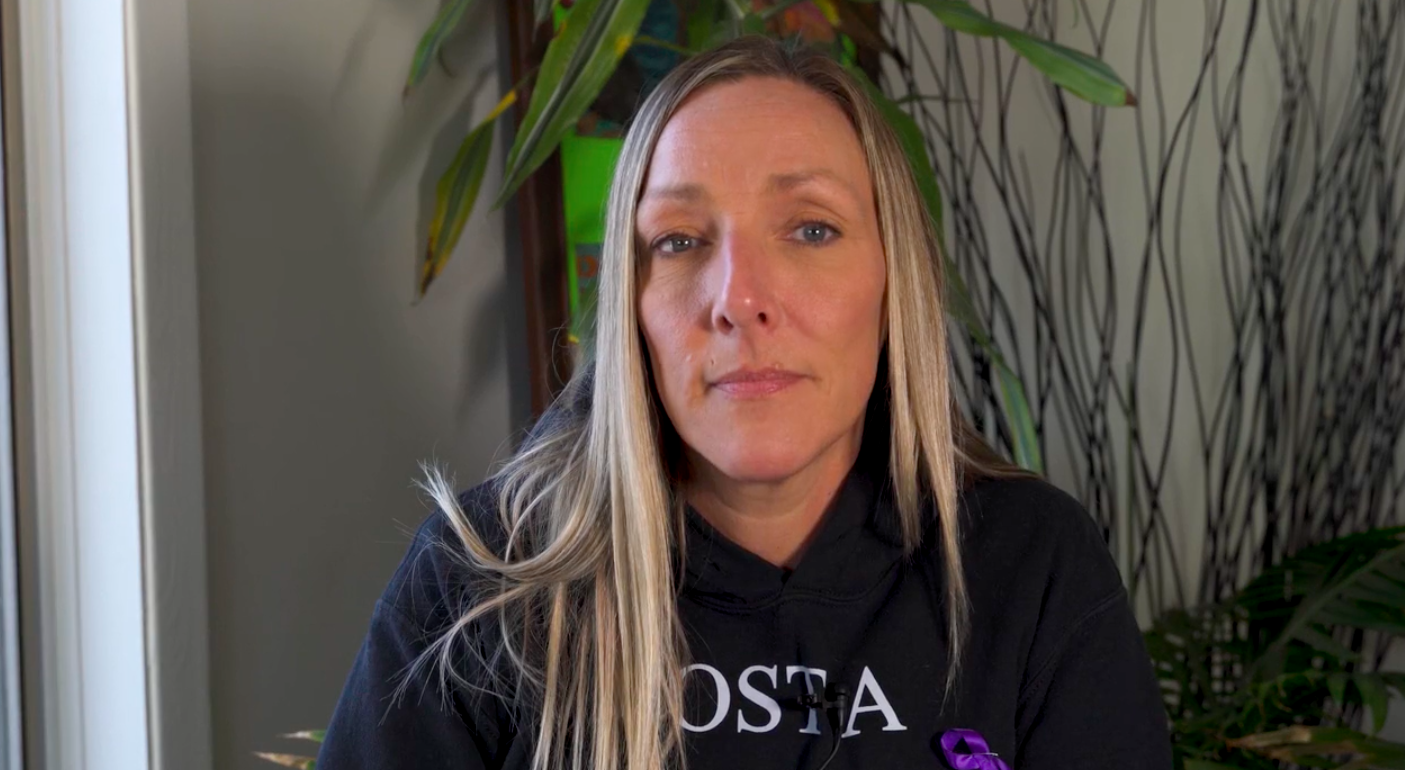Posts Tagged ‘expression’
Nicole – Using Art and Creativity to Express Grief
Nicole – Using Art and Creativity to Express Grief
Nicole discusses the work she does to allow access to creative outlets such as art hives and gardening.
There One Day and Gone the Next : Art Therapy and Grief
By Sarah Smith DTATI, BFA
Over the last 12 years or so, I’ve had the opportunity to work with those grieving individually and in group settings, which has provided me with experience and insight into how art therapy (and art as therapy) can be beneficial to those dealing with loss.
What is Art Therapy?
“Art therapy combines the creative process and psychotherapy, facilitating self-exploration and understanding. Using imagery, colour and shape as part of this creative therapeutic process, thoughts and feelings can be expressed that would otherwise be difficult to articulate,”(CATA, 2022).
There’s no right or wrong in art therapy, it’s a matter of using the art as a vessel for wellness along side a trained professional. There are many benefits one can receive from engaging in the art making process such as: healthy coping strategies, insight, emotional stability/balance, stress /anxiety reduction, grounding of emotions, pleasure/joy, creativity, safe space, expression, control, freedom, and connection among many others!
Art Therapy and Grief
Grief is a very layered and challenging thing that is unique for each individual who experiences loss.
Because there is no “proper” way to grieve, art therapy can make for an excellent coping strategy as it allows for each person to express themselves in the way that’s best for them.
Unlike traditional “talk therapy”, art therapy has the art, so this means that one does not need to speak if they don’t want to or if they cant find the way to articulate how they feel into words. Sometimes, while people are grieving they cant even pin point how they feel and at other times the emotions can just be so overwhelming it can affect one physically and to try and talk about the emotions just exacerbates them.
Creating art in itself can be a healing thing. It can be a fun or relaxing thing to do. Engaging in an art therapy session can allow for so many more benefits. The art therapist can provide the participant with specific art therapy directives and art materials that they feel may be beneficial to your needs. Art therapists are trained to read and assess clients’ artwork. This means they may see things you may have missed that you might benefit from if brought to your attention. This insight makes it a great learning tool for self-discovery. We as art therapists believe that the art work holds the subconscious. What’s great about this for those who are grieving is that people can process however they need to. Some people need more time to process, some people need a more gentle approach where they feel in control, some people refuse to acknowledge things, and some people are just going through the motions and engaging in the art making process. The subconscious is purging and the healing is happening whether they realize it or not.
Art Therapy Directives (examples)
I facilitated a workshop at a hospice a couple years ago and offered it to those who had lost a loved one. The workshop began with a few art therapy warm-up exercises with the intention of helping everyone feel a bit more comfortable in the space and with each other.
The first art therapy directive I had them do was make flowers out of coffee filters, markers, and water. I wanted them to make something symbolic for their loved one. They began by writing whatever they wanted onto the coffee filters. Some people wrote the persons name, poems, a memory, or even drew a picture. They then watered down the filters and the colours began to bleed. Some people cried during this part. They could resonate with the symbolism. The water like tears. The bleeding of the colours representing pain, fuzzy memories, and a distant grasp on the person. When the coffee filters had dried we had turned them into flowers. The transformation of taking what we lost and carrying it forward in a new way was very powerful to witness and a very healing thing to say the least.
The second art therapy directive was focused more on the individual rather than the deceased. I gave everyone a mask. I instructed them to paint the front of the mask how they appear to the world and I asked them to create on the inside of the mask to show how they really feel or how they are actually doing (see figure 1).
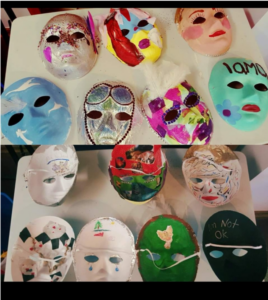
Figure 1.
They shared their art work from the workshop, but it was heavy. They were feeling sensitive and tired among other feelings so I had them sit and talk for a bit and then had them pull a self-care card for a distraction before letting them and drive home, as it may not have otherwise been safe for anyone overwhelmed after such an engaging session. This is typically how I run a grief workshop. Before they left the hospice asked them to fill out a score sheet to see how they felt about participating in the workshop and everyone said they liked it and for reasons, such as that they felt less anxious, they felt less alone, the felt lighter and more hopeful after the workshop.
At another hospice art therapy workshop, I had them create memory boxes. I provided them with a wooden box along with a variety of art materials, the only thing I asked was that they brought in a picture of the person they had lost. The purpose of this was to give them an opportunity to create something that could hold two energies, a place to honour them deceased, but also something tangible for them to have and hold. From my observations, I remember them taking a lot of time on these boxes and they were very quiet while making them. When they shared them, they were emotional, of course, but pride came through, it was like they made them for their people and wanted to make them well, so that their loved one would really like the box. This made them feel good for reasons such as honouring the person still while they are gone. Some people felt that their guilt had been eased a bit because they were physically doing something for that person who was no longer here. To see an example, see figure 2 and 2b.
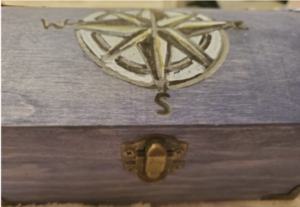
Figure 2
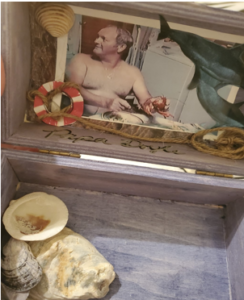
Figure 2b.
Following the memory boxes, I had them paint a step by step painting for their loved one. This was more of an art as therapy approach. This means they were literally using the art itself for wellness. They followed along with me and painted a whole painting. By following me, they were able to safely let go and get lost in the art making process. The intention was to enjoy the process while also giving them a healthy mental and emotional escape for however long it took us to paint the picture. I selected a picture of trees that had no leaves, purposely to symbolize letting go, loss, and reflection but the painting had an element of hope to it, the tress were pointing up to the sky, facing the light and there was lots of colour (see figure 3).
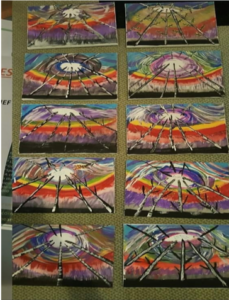
Figure 3.
The photos below are some examples of art from some of my sessions with clients around grief. They speak for themselves.
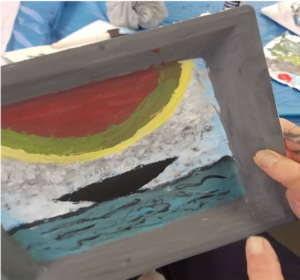
Figure 4.
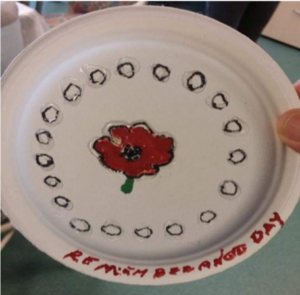
Figure 5.
Justin – Expression and grief
Justin – Expression and grief
Justin talks about what his grief is like and hope
Creative Outlets for Grief
Post by Maureen Pollard, MSW, RSW
Creative Outlets for Grief
In the depth of raw, deep grief it can be hard to find words to express your feelings. Perhaps you are not much of a talker, anyway. Maybe this terrible tragedy has left you speechless. There may be no words for the terrible experience you find yourself caught up in.
In times like this, expressive arts can provide a way for the feelings to flow. Such a release of feelings can ease the pain a little, as you put move some of the painful emotions gripping your heart out into the world. Making art can help shift the emotional burden you’re carrying, making it more manageable. Your creative pieces can help people understand what you feel like.
Music
Sing your sorrows out by making up lyrics to a familiar tune that brings you comfort. As your own words flow with the music you can feel the emotions flow, too.
Alternately, maybe you have a brand new melody rolling through your mind with words and phrases joining together to express your feelings. Writing your own song can be a powerful path to share your experience.
Drawing and Painting
Whether you prefer pencils, oil pastels or paints, creating images and using colour can be freeing. Sometimes an abstract piece that is full of colour or dark with shadows shows your internal landscapes as you navigate your grief. Other times it can feel comforting to create an image that is symbolic of your memories of the person who died and sentiments related to your grief.
Collage
Creating memorial collage, or a scrap-book style memento is an alternative to drawing and painting for those who feel more comfortable selecting images and words and arranging them together. Using photographs, personal mementos, old magazines and craft supplies, you can create a beautiful tribute to your person that honours your relationship and memories.
Dance and Theatre
Choreography of a series of movements especially designed to express the range of your feelings or in memory of your loved one. Creating scenes that represent important moments in your relationship, or incidents of your grief experience. Through physical actions such as these, you may gain a sense of relief as you embody emotion and bring your inner world to life.
Poetry
A poignant turn of phrase. A description that creates a vivid image. Words that link together thoughts, feelings and illustrations of your experience of love and loss. Poetry can be short and simple, or it can be long, meandering through events. It can rhyme, but it doesn’t have to.
Journaling and Memoir
Writing about your feelings and experiences can be healing. If you take time regularly to create a safe and comfortable space to write in, with privacy and permission, you can begin to understand what has happened. Writing can help you make sense of your story, and move it out into the world in a way that helps you feel relief. When your story is written and rewritten until it offers insight and recovery, it may even be ready to share with others to offer support, understanding and hope for those who come after you in your particular experience of loss.
It can be painful to talk about grief. Yet healing usually involves finding someway to hold the pain, to express the experience and shift your perspective in order to ease the burden of carrying loss that is yours for life. If talking is too hard, experiment with making art.
Remember:
- There is no way to do this wrong. All of your art is meaningful and important just because it is yours.
- You don’t have to share any art you don’t want to. This process is for your healing first and foremost.
- Your grief is your own to navigate, in your own way, at your own pace, with expressive art or without. You are always free to choose.
Cheryl – “What is grief”
Cheryl – “What is grief”
Cheryl defines grief and talks about how we all grieve differently.
Keith – “Difference between grief and mourning”
Keith – “Difference between grief and mourning”
Keith explains how grief is internal and mourning is external.

